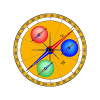Speaker
Matteo Rinaldi
(Universitat de València, Institut de Fisica Corpuscular and CSIC, Valencia, Spain)
Description
Double parton distribution functions (dPDFs), accessible in high energy proton-proton and proton nucleus collisions, in double parton scattering processes (DPS), represent a new and promising complementary tool, w.r.t. TMDs and GPDs, to explore the 3D partonic structure of the proton. In particular, they encode unknown information on how two partons are correlated in hadrons. To investigate how these partonic correlations affect these distributions, dPDFs have been calculated within the Light-Front approach with constituent quark models (M. Rinaldi et al JHEP 2014). In this scenario, we showed how dynamical correlations, induced by the used model, prevent the factorization of dPDFs in terms of standard PDFs, a common assumption in experimental analyses. Moreover, we have investigated how these correlations affect the so called effective cross section, $\sigma_{eff}$, fundamental ingredient for the comprehension of the role of DPS in proton-proton collisions used in experimental studies. To calculate this quantity, dPDFs have been evolved at very high scales through the pQCD evolution procedure. The main evidence of partonic correlations is represented by the $x$ dependence of $\ss$, being $x$ the longitudinal momentum fraction carried by a parton inside the hadron (M. Rinaldi et al PLB 2016). Due to the importance of partonic correlations, we have addressed the role of perturbative, non perturbative and relativistic correlations, including sea quarks and gluons non perturbatively generated (M. Rinaldi et al JHEP 1610 (2016) 063, Phys.Rev. D 2017). We also calculated the DPS cross section for the same sign $W$ pair production process using, as non perturbative input, dPDFs evaluated within a constituent quark model. We showed that partonic correlations could be observed in next LHC run (F. A. Ceccopieri et al Phys.Rev. D 2017).
Primary author
Matteo Rinaldi
(Universitat de València, Institut de Fisica Corpuscular and CSIC, Valencia, Spain)
Co-authors
Federico Alberto Ceccopieri
(Université de Liège)
Marco Claudio Traini
(TIFP)
Sergio Scopetta
(PG)
Vicente Vento
(Universitat de València, Institut de Fisica Corpuscular and CSIC, Valencia, Spain)

